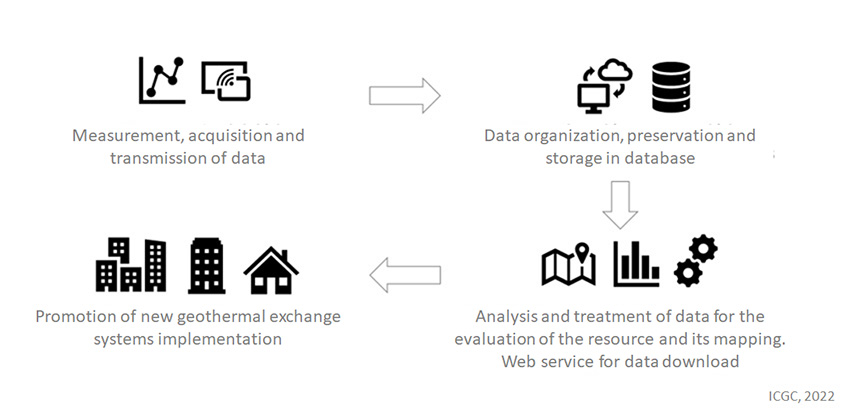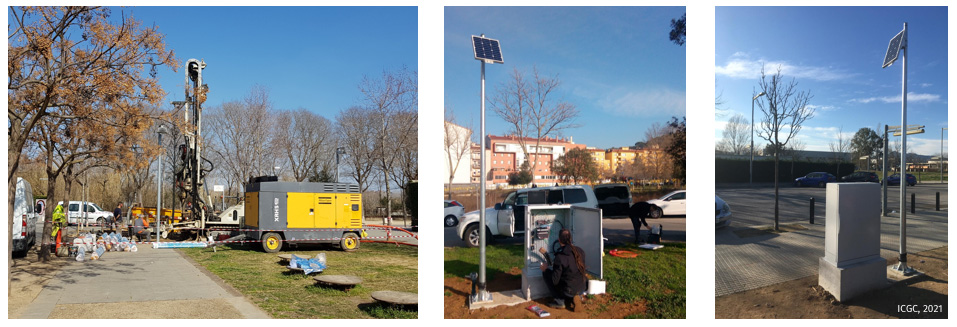Use of the collected data, operation of the XEGCat and technologies used
The monitoring networks of the XEGCat project provide data that can be used for the evaluation and elaboration of maps and the modelling of the surface geothermal resource available at urban scales, but also for the simulation and design of concrete projects for the use of heat exchange with geothermal heat pumps. Stations are equipped with sensors of various characteristics to measure and record the subsoil temperature at various depths and the position of the piezometric level in the existing aquifers. The records are continuous and allow for a vision of the evolution and seasonality of these variables over time. The data also makes it possible to define and map the thermal regime of the land and to carry out specific studies of the Subsurface Urban Heat Island effect or SUHI. They even make it possible to recognize the effects of climate change once a sufficiently long data series is available.
The acquisition systems can be equipped with a telemetry system powered by a 30 W photovoltaic panel and SIM cards that allow data to be automatically sent to the ICGC server, or they can be stored on site to be collected periodically in the field. The data is uploaded and organized by the NetMon© spatial database management system (the ICGC measurement and control station monitoring system) from which, and through a web service, they can be consulted, analysed and downloaded through the ICGC Geoíndex viewer - Network of Geothermal Stations of Catalonia (XEGCat).

Conceptual scheme of the XEGCat project

Implementation works of the monitoring network in an urban environment. On the left, drilling of a borehole for the installation of a station.
In the center, instrumentation implementation works. On the right, station prepared for the collection and transmission of data.
Implementation status of the XEGCat project (updated, September 2023)
The first network of geothermal stations of the XEGCat project was implemented between 2019 and 2020, and is located in the urban and peri-urban areas of the municipalities of Girona, Salt and Vilablareix, with a total of 11 newly built points and the fitting of 11 additional pre-existing points. The typology of the points implemented, the instrumentation and other configuration data can be consulted on the website XEGCat de Girona-Salt and Vilablareix (2019-2020).
In 2022 the implementation of the second network in the urban area of the city of Tarragona started. 14 boreholes will be drilled to be instrumentalized and additional pre-existent groundwater points will be added. The use of fibre optics will be implemented to monitor the temperature in depth. The type of the implemented points, its instrumentalization and other data can be consulted in the webpage XEGCat de Tarragona (2021-2023).
Also in 2023, a third network is expected to be deployed in the municipality of Vielha (Val d’Aran) within the framework of the Vielha Smart MicroDHC grid project, collaborating with the Conselh Generau d’Aran and the town council of Vielha and Mijaran. This is a future project to develop an urban network of hot and cold thermal conditioning powered by the use of a hybrid geothermal and other renewables sources to supply energy to the following public services of the town of Vielha: the Palai de Gèu, Palai d'Espòrts, IES Aran high school and Garona public school. The implemented network will allow the generation of the geologic, hydrogeologic and geothermal studies that are needed to design the geothermal catchment area for the project to be successful..
ICGC Geoindex- XEGCat viewer
Currently, the data recorded by the monitoring stations of the primary and secondary network of the XEGCat of Girona-Salt and Vilablareix (2019-2020) can be consulted.
Graph form data can be consulted and visualized for each of the stations or control points for up to a year. Graphs show the temperature (ºC) and/or piezometric level (masl) variables with respect to time.
In the selection menu it is possible to choose, firstly, the variable or variables desired to be displayed, the time range in which the query is being made, the stations for which the query is being made and, finally, the sensors of each station for which the data is wanted.
The viewer allows downloading the data in CSV format. For each station, it is also possible to view and download the lithological column of the monitoring station. In the case of the primary network stations, the columns are directly a result of the perforation performed for the deployment of the XEGCat project. In the case of the secondary network stations, the lithological columns come from the existing bibliographic information.
Viewer
Full screen viewer: https://visors.icgc.cat/geotermia-estacions
References
AENOR UNE-100715:2014 (2014): “Diseño, ejecución y seguimiento de una instalación geotérmica somera. Parte 1: Sistemas de circuito cerrado vertical”.
ASHRAE (American Society of Heating, Refrigerating, and Air Conditioning Engineers) (1985): “ASHRAE Handbook of Fundamentals Volume”.
Blum, P.; Benz, S.A.; Menberg, K.; Bayer, P. (2016): "Subsurface urban heat islands: A renewable source of energy?". Karlsruhe Institute of Technology (KIT). I Congreso internacional Madrid Subterra para la exploración y explotación de la energía del subsuelo https://www.madridsubterra.es/ponencias/
García-Céspedes, J.; Herms, I.; Arnó, G.; Ariza, J.; De Felipe, J. J. (2021): "Geo-SIV (v1.0) [programari]". Institut Cartogràfic i Geològic de Catalunya. CC-BY 4.0.
Herms, I., Arnó, G., Camps, V., Colomer, M., Armengol, S., Caldera, N., Orriols, E., Marcè, T., Elvira, À., Jara, J. A., Struth, L., Garcia-Céspedes, J., and Piris, G. (2024): The "XEGCat project" - The subsurface monitoring network for shallow geothermal research in urban areas of Catalonia, EGU General Assembly 2024, Vienna, Austria, 14–19 Apr 2024, EGU24-6479, https://doi.org/10.5194/egusphere-egu24-6479.
ICGC (2018): “Geoíndex. Geotèrmia superficial”. Institut Cartogràfic i Geològic de Catalunya. Disponible a través del següent enllaç: www.icgc.cat/ca/Administracio-i-empresa/Eines/Visualitzadors-Geoindex/Geoindex-Geotermia-superficial.
IDAE (Instituto para la Diversificación y el Ahorro Energético) (2012): “Guía técnica de diseño de sistemas de intercambio geotérmico de circuito cerrado”.
Ingersoll, L.R.; Plass, H.J. (1948): “Theory of the ground pipe heat source for the heat pump”. ASHVE Trans., 47: 339-348.
IGSHPA (International Ground Source Heat Pump Association) (2009): “Ground source heat pump residential and light commercial: design and installation guide”.
UK Geoenergy Observatories (Energy Security and Innovation Observing System). Bristish Geological Survey. https://ukgeos.ac.uk/.
MITMA (Ministerio de Transportes, Movilidad y Agencia Urbana) (2019): “Código Técnico de la Edificación (CTE). Documento Básico HE Ahorro de energía (HE)”.
NRCAN (Ministry of Natural Resources, Canada) (2005): “RETScreen® International: Clean Energy Decision Support Centre. Ground-Source Heat Pump Project Analysis”. Disponible a través del següent enllaç: https://publications.gc.ca/collections/Collection/M39-111-2005E.pdf.
NRCAN (Ministry of Natural Resources, Canada) (2016): “RETScreen® International: “RETScreen Clean Energy Management Software”. Disponible a través del següent enllaç: www.nrcan.gc.ca/maps-tools-and-publications/tools/modelling-tools/retscreen/7465.
Yang, H.; Cui, P.; Fang, Z. (2019): “Vertical-borehole ground-coupled heat pumps: A review of models and Systems”, Applied Energy, 87: 16-27.

 Contact
Contact









